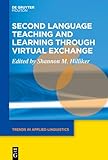Second Language Teaching and Learning through Virtual Exchange / ed. by Shannon M. Hilliker.
Material type: TextSeries: Trends in Applied Linguistics [TAL] ; 29Publisher: Berlin ; Boston : De Gruyter Mouton, [2022]Copyright date: ©2022Description: 1 online resource (XIII, 286 p.)Content type:
TextSeries: Trends in Applied Linguistics [TAL] ; 29Publisher: Berlin ; Boston : De Gruyter Mouton, [2022]Copyright date: ©2022Description: 1 online resource (XIII, 286 p.)Content type: - 9783110727234
- 9783110727463
- 9783110727364
- 418.0071 23
- online - DeGruyter
- Issued also in print.
| Item type | Current library | Call number | URL | Status | Notes | Barcode | |
|---|---|---|---|---|---|---|---|
 eBook
eBook
|
Biblioteca "Angelicum" Pont. Univ. S.Tommaso d'Aquino Nuvola online | online - DeGruyter (Browse shelf(Opens below)) | Online access | Not for loan (Accesso limitato) | Accesso per gli utenti autorizzati / Access for authorized users | (dgr)9783110727364 |
Frontmatter -- Preface -- Contents -- Introduction -- Language and virtual exchange -- Chapter 1 Learning-oriented assessment in an international virtual exchange -- Chapter 2 From demotivation to Intercultural Communicative Competence (ICC): Japanese university learner journeys in the International Virtual ExchangeProject (IVEProject) -- Chapter 3 Annotating appraisal in a mobile telecollaboration project: A linguist -- Chapter 4 Learner appropriation of genre in a US-China virtual exchange -- Chapter 5 “Zoom” in and speak out: Virtual exchange in language learning -- Culture and virtual exchange -- Chapter 6 Developing intercultural communicative competence in ESP contexts through virtual exchange: An ecological perspective -- Chapter 7 Video exchange telecollaboration: Towards developing interculturality in EFL environments -- Chapter 8 Taking action in a virtual exchange with Brazilian and U.S. students -- Chapter 9 Tackling problems, finding solutions: Creativity and collaboration in crosscultural virtual exchange during a pandemic -- Teacher education and virtual exchange -- Chapter 10 Integrating the United Nations’ Sustainable Development Goals into a teacher preparation program: Developing content for virtual exchanges -- Chapter 11 Enhancing ELLs’ understanding through the use of examples, questions, and native language connections during virtual exchange -- Chapter 12 Developing linguistically responsive pedagogy among K-12 mainstream teacher candidates through virtual exchange -- Chapter 13 Virtual exchange to enhance English language teacher trainees’ professional development – insights from a Czech- Polish project -- Conclusion -- Index
restricted access online access with authorization star
http://purl.org/coar/access_right/c_16ec
Virtual exchanges provide language learners with a unique opportunity to develop their target language skills, support inter-cultural exchange, and afford teacher candidates space to hone their teaching craft. The research presented in this volume investigates the role of virtual exchanges as both a teaching tool to support second language acquisition and a space for second language development. Practitioners obtain guidance on the different types of exchanges that currently exist and on the outcome of those exchanges so that they can make informed decisions on whether to include this type of program in their language teaching and learning classrooms. To this end, this edited volume contains chapters that describe individual virtual exchanges along with results of research done on each exchange to show how the exchange supported specific second language teaching and learning goals.
Issued also in print.
Mode of access: Internet via World Wide Web.
In English.
Description based on online resource; title from PDF title page (publisher's Web site, viewed 25. Jun 2024)


